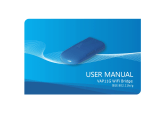
Getting Started
8
Universal Dual Band WiFi Range Extender WN2500RP
When to Use Your Extender
NETGEAR recommends that you connect to the extender only when your home network
connection is poor. Because data traffic routed through the extender is inherently slower than
traffic routed directly from the network, the computer should stay on the network if the
connection is good enough. NETGEAR recommends that you connect through the extender
network only when the computer is in a “dead zone” where connection from the network is
very poor or non-existent.
The extender LEDs can help you tell if the extender is correctly set up and working as it
should.
• The best performance is delivered when a the Link Rate LED
or and the
Wireless Device to Extender LED
are green.
• A workable performance is delivered when the Link Rate LED is amber and the Wireless
Device to Extender LED
is green.
Positioning Your Extender
The ideal location to place the extender is half-way between your wireless router and your
computer.
The best connection is established when there is a clear line of sight between the extender
and the wireless router and also a clear line of sight between the extender and the computer
you are using. If this straight path is blocked by a thick wall or other materials, move the
extender to a dif
ferent location half-way between the computer and the router.
If there is no power outlet nearby, or you prefer to place the extender elsewhere, move the
extender closer to the computer
. If the Link Rate LED is green or amber and the Wireless
Device to Extender LED is green, the extender is working as expected.
To improve the Link Rate LED from red or amber to green:
• Once you successfully connect to the extender from a computer that is outside the range
of your router and log in to www.mywifiext.net, the Smart Wizard guides you through the
process to connect the extender to a router
.
• If the Link Rate LED is red or the Smart Wizard cannot connect the extender to a router,
move the extender closer to the router or to a dif
ferent spot where it provides a better line
of sight. As you move the extender, continue to check the Link Rate and the Wireless
Device to Extender LEDs on the front panel until you find a location where the Link Rate
LED is green or amber, and the Wireless Device to Extender LED is green. Note that you
might have to unplug the extender as you move it to a different location. If you do, from
the new location, power up the extender and continue to check the LEDs.
Once the LEDs show that the extender is in a good location, open a browser and go to
http://www
.mywifiext.net
to continue the setup process.




















